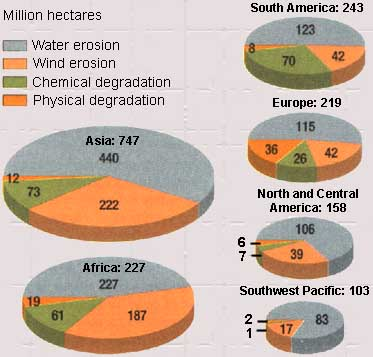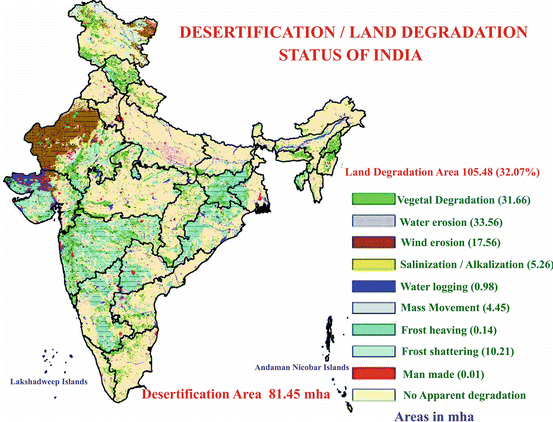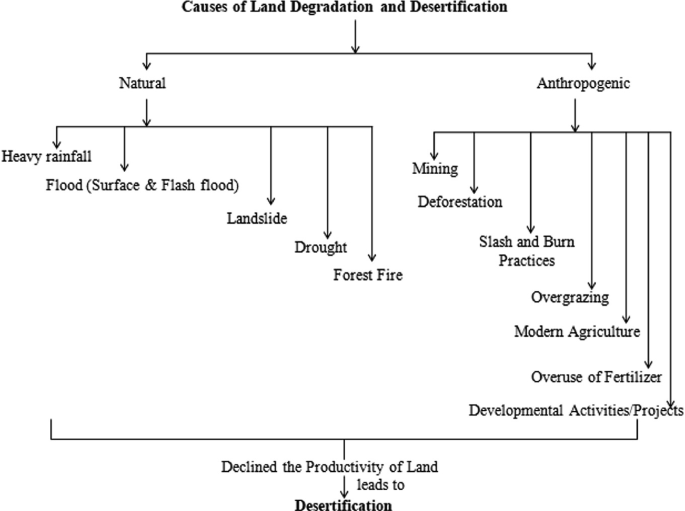Reimagining Land Management for Sustainable Development | 27 Feb 2024
This editorial is based on “An expansive land management policy is overdue” which was published in The Hindu on 27/02/2024. The article emphasises the need for urgent action in a previously overlooked area of public policy and human welfare: caring for the long-term sustainability of land, soil, and water resources.
For Prelims: UN Convention to Combat Desertification (UNCCD), Land Degradation, Greenhouse Gas Emissions (GHG), Land Degradation Neutrality, Delhi Declaration of 2019, Conference of Parties (COP-14).
For Mains: Desertification and its impact, Land degradation and its Challenges
Land is central to all human activities. It provides ecological, economic, social, and cultural services. But this multi-dimensional character of land is often overlooked in land management practices, resulting in excessive stress, land degradation, and environmental draw down.
Globally, the annual losses of ecosystem services due to land degradation has been estimated at USD 6 trillion. The United Nations Convention to Combat Desertification (UNCCD)’s 14th Conference of Parties (COP14) in New Delhi in 2019 specifically discussed the problem of land degradation experienced by different countries and the need to find ways of achieving Land Degradation Neutrality (LDN).
What is the Current Status of Land Degradation?
- Global Scenario:
- There are significant disparities when it comes to the proportion of degraded land per region. Sub-Saharan Africa, Western and Southern Asia, Latin America, and the Caribbean experienced land degradation at rates faster than the global average during 2015-2019.
- Eastern and Central Asia, Latin America, and the Caribbean regions experienced the most severe degradation, affecting at least 20% of their total land area, as of 2019.
- However, since 2015, the proportion of land degraded in Sub-Saharan Africa has increased from 6.7% to 14.63%, and in Western Asia and the Northern African region, the same has risen from 3.78% to 7.18%.
- UNCCD Data Regarding India:
- From 2015-2019, 30.51 million hectares of India’s total reported land was degraded, according to UNCCD data. This means that 9.45% of the country's landmass was degraded as of 2019. This was 4.42% in 2015.
- The UNCCD data dashboard also reflected that 251.71 million Indians constituting 18.39% of the country’s population were exposed to land degradation during the same period.
- Moreover, it added, 854.4 million of the country’s people were exposed to drought from 2015-2018.
- According to Desertification and Land Degradation Atlas of India:
- Desertification and Land Degradation Atlas of India, published by Space Applications Centre (SAC) Indian Space Research Organisation (ISRO) which provides the extent of land degradation and desertification in India, states that the land degradation and desertification in the country has been estimated to be 97.84 million hectares in 2018-19.
- It provides state-wise area of degraded land which is helpful in planning and implementation of schemes aimed at restoration of land by providing important data and technical inputs.
What are the Different Causes of Land Degradation?
In the preparation of a world map as a first systematic evaluation of the status of human- induced soil degradation, Global Assessment of Soil Degradation (GLASOD) identified seven different causes of human interventions that have resulted in soil degradation worldwide:
- Soil Erosion and Nutrient Depletion:
- Soil erosion is a serious form of land degradation in croplands closely associated with unsustainable land management in combination with climatic parameters, some of which are subject to climate change.
- High winds can blow away loose soil from flatter, hilly terrains. Water erosion generally occurs on slopes and its severity increases with the severity of slope.
- Soil erosion is mainly caused in areas of crop land expansion, particularly in sub-Saharan Africa, South America and Southeast Asia. Soil can also be eroded away by wind and water.
- Deforestation:
- Deforestation and the removal of the natural vegetation for fuel wood, agriculture and industry is increasing at an alarming rate and this is causing serious land degradation on 579 million ha of which 50% is located in Asia, followed by South America with 17%.
- The World Bank estimates that about 10 million km2 of forest have been lost since the beginning of the 20th century. In the past 25 years, forests shrank by 1.3 million km2, an area bigger than the size of South Africa.
- Overgrazing by Livestock:
- Overgrazing by cattle reduces plant cover, eliminating the most desirable forage species first. This opens up the land to undesirable weeds, brush, and trees and leads to increasing soil erosion and lower soil fertility. The land becomes less and less productive.
- In South America the overexploitation of vegetation for domestic use is largely confined to dry land areas of North-West Argentina and southern Bolivia where shrubs are collected for firewood.
- Traditional Farming Practices:
- It refers to a type of farming practice that farmers are following without properly identifying the relationship between crop soils requirement and without following several soil and water conservation measures which are highly vital for conservation of land resources, compromising future generation benefits.
- The protective layer called topsoil is eroded away through this backward farming system, rendering the land unproductive.
- Loss of Vegetative Cover:
- The lack of permanent vegetative cover in certain locations results in extensive wind erosion. Loose, dry, bare soil is the most susceptible; however, crops that produce low levels of residue (e.g., soybeans and many vegetable crops) may not provide enough resistance.
- Population Growth:
- India confronts severe pressure on agricultural land. Over the past fifty years, while India's total population increased by about 3 times, the total area of land under cultivation increased by only 15.92% from 118.75 to 141.23 million hectares.
- Despite past expansion of the area under cultivation, less agricultural land is available to feed each person in India. The extent of agricultural intensification and extensification is characterised by increase in cropping and irrigation intensity and higher use of chemical fertilisers, pesticides and insecticides.
- The process of agricultural extensification and intensification is leading to land degradation, overexploitation of underground water resources, increased use of chemical fertilisers.
- Impact of Climate Change:
- Changes in rainfall patterns, such as distribution in time and space, and intensification of rainfall events increase the risk of land degradation.
- Landslides are a form of land degradation induced by extreme rainfall events. There is a strong theoretical reason for increasing landslide activity due to intensification of rainfall.
- Erosion of coastal areas as a result of sea level rise will increase worldwide. In cyclone prone areas (such as the Caribbean, Southeast Asia and the Bay of Bengal), the combination of sea level rise and more intense cyclones, will lead to land subsidence in the areas.
- Changes in rainfall patterns, such as distribution in time and space, and intensification of rainfall events increase the risk of land degradation.
What are the Different Challenges in Management of Land Degradation in India?
- Acute Disparity Between Land Area and Population:
- India with only 2.4% of the world's geographical area and more than 17% of the world population experiences several land management challenges. Arable land in India is around 55% of total geographical area and forest cover accounts for another 22%. The rest is desert, mountains, etc.
- Around 30% of total geographical area is degraded land. Access to agricultural land continues to be an important livelihood issue as a significant share of the population depends on agriculture for their sustenance.
- Development targets and the demand for land to accommodate the growing population, infrastructure, rapid urbanisation, and social, cultural, and environmental aspects are placing unprecedented pressure on land.
- India with only 2.4% of the world's geographical area and more than 17% of the world population experiences several land management challenges. Arable land in India is around 55% of total geographical area and forest cover accounts for another 22%. The rest is desert, mountains, etc.
- Competition Between Agriculture and Other Land-resources Based Sectors:
- Continuously increasing stress on land results in competition among farmers and between agriculture and other land resource-based sectors, as well as land use conflicts, escalation of land prices, and changing land rights. Across the country, natural areas are being squeezed and ecological functions being lost.
- Adverse Effects of Climate Change:
- Not only does land degradation adversely affect the livelihood opportunities of the people who directly depend on environmental resources, but also the buffering effects of natural ecosystems in the face of disasters such as floods and droughts, temperature rise, and environmental pollution are severely compromised.
- Sectoral Approach to Land Management:
- In India, current land management practices are sectoral with each department following its own approach. Land management falls under the purview of State governments. Further, cultural land is privately owned and land-use decisions are constitutionally vested with the owner which creates issues in adopting synchronised approach.
- Inadequate Land Management Practices:
- Apart from the administrative complexity, the challenges to adopt and implement appropriate land management practices in the country include knowledge gaps, a short-term planning bias, a fragmented approach, lack of action for unforeseen events, and regulatory barriers.
What are the Suggestions for Effectively Managing the Land Degradation?
- Setting Up Multi-Stakeholder Platform:
- As a critical mechanism to achieving sectoral integration and addressing the challenges, it is imperative to set up a multi-stakeholder platform at the district and sub-district levels to bring together farmers, other land managers, policymakers, civil society organisations, business leaders, and investors under a common platform.
- Article 243ZD (1) of the Constitution provides for district planning committees to consolidate plans from panchayats and municipalities. This committee may be activated in the direction of preparing a land management plan, covering both agricultural and non-agricultural sectors.
- Following the Climate-Smart Landscape Approach:
- A landscape approach will be useful in this context as it will provide deep insights to assess the potential of land and the scope of allocation and reallocation of land for appropriate uses. This will help evaluation, negotiation, trade off, and decision-making.
- A climate-smart landscape approach will contribute to climate objectives, increased agricultural production, improved local livelihoods and the conservation of biodiversity.
- Promoting Integrated Landscape Management:
- Science has shown the importance of considering land as a system and promoting integrated landscape management. There is considerable experience on the ground to follow this approach, but systematic institutional support is hardly available.
- The European Landscape Convention proclaimed that landscape is a key element of individual and social well-being.
- The UK Parliamentary Office of Science and Technology in its Brief 42, ‘Sustainable land management: managing land better for environmental benefits’, in 2021 observed that tackling the biodiversity crisis is embedded in and dependent on how land is managed”.
- Science has shown the importance of considering land as a system and promoting integrated landscape management. There is considerable experience on the ground to follow this approach, but systematic institutional support is hardly available.
- Ensuring Involvement of Different Actors:
- Perhaps, India’s parliamentarians can initiate deliberations on the emerging challenges of integrated land management practices and help devise appropriate policies for long-term sustainability by involving all actors across the scale, both horizontal and vertical.
- Country Level Stock-Taking of Land Management:
- The Intergovernmental Panel on Climate Change’s special report on ‘Climate Change and Land’ (2019) suggested country-level stocktaking of land management practices.
- It also proposed several near- and long-term actions with the thrust on land management options that reduce competition for land with co-benefits and minimum negative impacts on key ecosystem services.
- Stand of Food and Agriculture Organisation (FAO):
- The FAO report, ‘State of the World’s Land and Water Resources for Food and Agriculture: The System at Breaking Point’ (2021), argued that a sense of urgency needs to prevail over a hitherto neglected area of public policy and human welfare— that of caring for the long-term future of land, soil, and water.
What are the Different Initiatives Taken to Control Land Degradation?
- Global Initiatives:
- National Initiatives:
Conclusion
Land plays a pivotal role in supporting various human activities by providing ecological, economic, social, and cultural services. However, the multi-dimensional nature of land is often overlooked, leading to excessive stress, degradation, and environmental depletion.
In India, with its limited geographical area and a large population dependent on agriculture, there are significant challenges in managing land sustainably. To address these challenges, a multi-stakeholder platform at the district and sub-district levels, along with a landscape approach, can be instrumental in integrating sectoral interests and ensuring the long-term sustainability of land resources.
|
Drishti Mains Question: Discuss the challenges of land degradation in India, its implications on agriculture, environment, and livelihoods, and suggest measures for sustainable land management. |
UPSC Civil Services Examination, Previous Year Questions
Prelims:
Q. What is/are the importance/importances of the ‘United Nations Convention to Combat Desertification'? (2016)
- It aims to promote effective action through innovative national programmes and supportive international partnerships.
- It has a special/particular focus on South Asia and North Africa regions, and its Secretariat facilitates the allocation of major portion of financial resources to these regions.
- It is committed to a bottom-up approach, encouraging the participation of local people in combating desertification.
Select the correct answer using the code given below:
(a) 1 only
(b) 2 and 3 only
(c) 1 and 3 only
(d) 1, 2 and 3
Ans: (c)
Mains:
Q. The process of desertification does not have climate boundaries. Justify with examples. (2020)
Q. In what way micro-watershed development projects help in water conservation in drought-prone and semi-arid regions of India? (2016)




